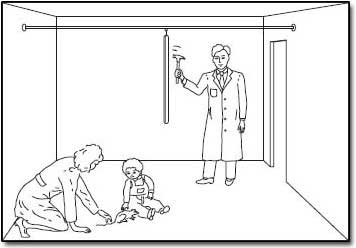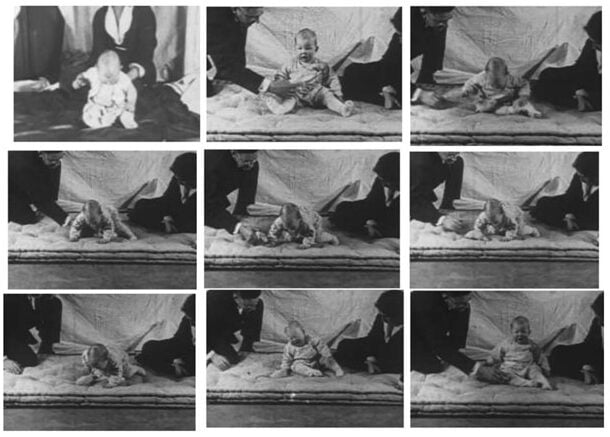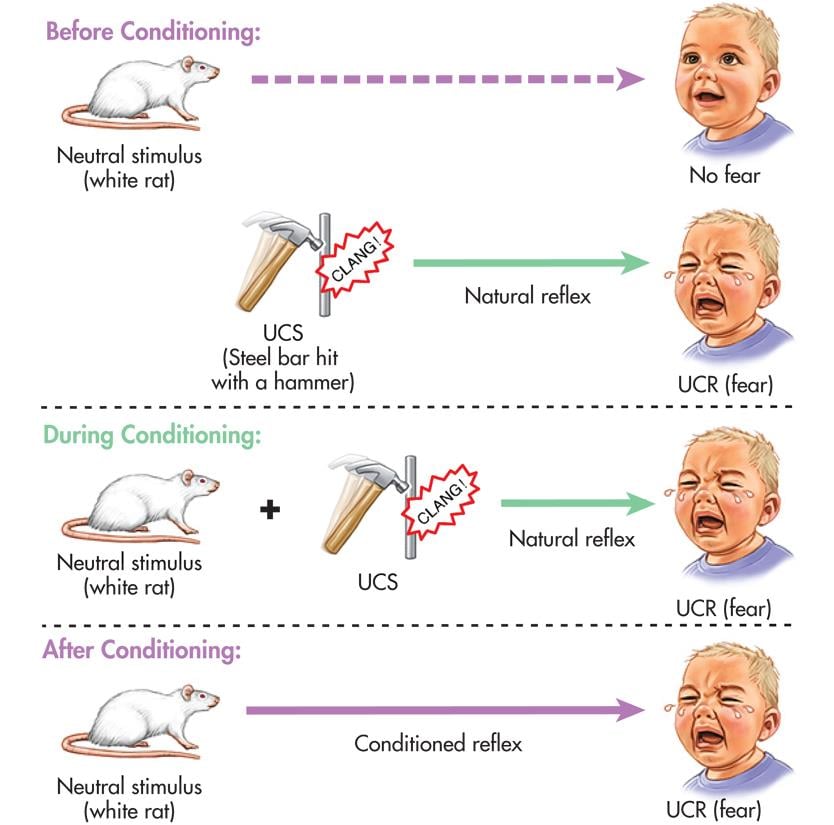Watson and Rayner (1920) conducted the Little Albert Experiment to answer 3 questions:
-
Can an infant be conditioned to fear an animal that appears simultaneously with a loud, fear-arousing sound?
-
Would such fear transfer to other animals or inanimate objects?
-
How long would such fears persist?
Little Albert Experiment
Ivan Pavlov showed that classical conditioning applied to animals. Did it also apply to humans? In a famous (though ethically dubious) experiment, John Watson and Rosalie Rayner showed it did.
Conducted at Johns Hopkins University between 1919 and 1920, the Little Albert experiment aimed to provide experimental evidence for classical conditioning of emotional responses in infants
At the study’s outset, Watson and Rayner encountered a nine-month-old boy named “Little Albert” (his real name was Albert Barger) – a remarkably fearless child, scared only by loud noises.
After gaining permission from Albert’s mother, the researchers decided to test the process of classical conditioning on a human subject – by inducing a further phobia in the child.
The baseline session occurred when Albert was approximately nine months old to test his reactions to neutral stimuli.
Albert was reportedly unafraid of any of the stimuli he was shown, which consisted of “a white rat, a rabbit, a dog, a monkey, with [sic] masks with and without hair, cotton wool, burning newspapers, etc.” (Watson & Rayner, 1920, p. 2).
Approximately two months after the baseline session, Albert was subjected during two conditioning sessions spaced one week apart to a total of seven pairings of a white rat followed by the startling sound of a steel bar being struck with a hammer.

When Little Albert was just over 11 months old, the white rat was presented, and seconds later, the hammer was struck against the steel bar.
After seven pairings of the rat and noise (in two sessions, one week apart), Albert reacted with crying and avoidance when the rat was presented without the loud noise.
By the end of the second conditioning session, when Albert was shown the rat, he reportedly cried and “began to crawl away so rapidly that he was caught with difficulty before reaching the edge of the table” (p. 5). Watson and Rayner interpreted these reactions as evidence of fear conditioning.
By now, little Albert only had to see the rat and immediately showed every sign of fear. He would cry (whether or not the hammer was hit against the steel bar), and he would attempt to crawl away.
The two conditioning sessions were followed by three transfer sessions. During the first transfer session, Albert was shown the rat to assess maintained fear, as well as other furry objects to test generalization.
Complicating the experiment, however, the second transfer session also included two additional conditioning trials with the rat to “freshen up the reaction” (Watson & Rayner, 1920, p. 9), as well as conditioning trials in which a dog and a rabbit were, for the first time, also paired with the loud noise.
This fear began to fade as time went on, however, the association could be renewed by repeating the original procedure a few times.
Unlike prior weekly sessions, the final transfer session occurred after a month to test maintained fear. Immediately following the session, Albert and his mother left the hospital, preventing Watson and Rayner from carrying out their original intention of deconditioning the fear they have classically conditioned.

Experimental Procedure
| Session | Age | Stimuli Shown |
|---|---|---|
| 1 | 8 months & 26 days | Included tests with rat, rabbit, dog, monkey, masks with and without hair, cotton wool, and burning newspapers (no fear). |
| 2 | 11 months & 3 days | Rat paired with loud noise (two pairings). |
| 3 | 11 months & 10 days | Test with rat alone (elicited mild fear). Rat paired with loud noise (5 pairings). Test with rat alone (elicited strong fear). |
| 4 | 11 months & 15 days | Tests with rat, rabbit, dog, fur coat, cotton wool, Watson’s hair, 2 observers’ hair, and Santa Claus mask. |
| 5 | 11 months & 20 days | In original testing room: tests with rat, rabbit, and dog; an extra conditioning trial with rat; and conditioning trials with rabbit and dog (1 pairing each). In a new room: tests with rat, rabbit, and dog; extra conditioning trial with rat; plus barking incident with dog. Included comment that all previous tests had been conducted on a table. |
| 6 | 12 months, 21 days | Tests with Santa Claus mask, fur coat, rat, rabbit, and dog. Albert was also discharged from the hospital on this day. |
Classical Conditioning
- Neutral Stimulus (NS): This is a stimulus that, before conditioning, does not naturally bring about the response of interest. In this case, the Neutral Stimulus was the white laboratory rat. Initially, Little Albert had no fear of the rat, he was interested in the rat and wanted to play with it.
- Unconditioned Stimulus (US): This is a stimulus that naturally and automatically triggers a response without any learning. In the experiment, the unconditioned stimulus was the loud, frightening noise. This noise was produced by Watson and Rayner striking a steel bar with a hammer behind Albert’s back.
- Unconditioned Response (UR): This is the natural response that occurs when the Unconditioned Stimulus is presented. It is unlearned and occurs without previous conditioning. In this case, the Unconditioned Response was Albert’s fear response to the loud noise – crying and showing distress.
- Conditioning Process: Watson and Rayner then began the conditioning process. They presented the rat (NS) to Albert, and then, while he was interacting with the rat, they made a loud noise (US). This was done repeatedly, pairing the sight of the rat with the frightening noise. As a result, Albert started associating the rat with the fear he experienced due to the loud noise.
- Conditioned Stimulus (CS): After several pairings, the previously Neutral Stimulus (the rat) becomes the conditioned stimulus, as it now elicits the fear response even without the presence of the loud noise.
- Conditioned Response (CR): This is the learned response to the previously neutral stimulus, which is now the Conditioned Stimulus. In this case, the Conditioned Response was Albert’s fear of the rat. Even without the loud noise, he became upset and showed signs of fear whenever he saw the rat.

In this experiment, a previously unafraid baby was conditioned to become afraid of a rat. It also demonstrates two additional concepts, originally outlined by Pavlov.
- Extinction: Although a conditioned association can be incredibly strong initially, it begins to fade if not reinforced – until is disappears completely.
- Generalization: Conditioned associations can often widen beyond the specific stimuli presented. For instance, if a child develops a negative association with one teacher, this association might also be made with others.
Over the next few weeks and months, Little Albert was observed and ten days after conditioning his fear of the rat was much less marked. This dying out of a learned response is called extinction.
However, even after a full month, it was still evident, and the association could be renewed by repeating the
original procedure a few times.
Unfortunately, Albert’s mother withdrew him from the experiment the day the last tests were made, and Watson and Rayner were unable to conduct further experiments to reverse the condition response.
Summary:
- The Little Albert experiment was a controversial psychology experiment by John B. Watson and his graduate student, Rosalie Rayner, at Johns Hopkins University.
- The experiment was performed in 1920 and was a case study aimed at testing the principles of classical conditioning.
- Watson and Raynor presented Little Albert (a nine-month-old boy) with a white rat, and he showed no fear. Watson then presented the rat with a loud bang that startled Little Albert and made him cry.
- After the continuous association of the white rat and loud noise, Little Albert was classically conditioned to experience fear at the sight of the rat.
- Albert’s fear generalized to other stimuli that were similar to the rat, including a fur coat, some cotton wool, and a Santa mask.
Critical Evaluation
Methodological Limitations
The study is often cited as evidence that phobias can develop through classical conditioning. However, critics have questioned whether conditioning actually occurred due to methodological flaws (Powell & Schmaltz, 2022).
- The study didn’t control for pseudoconditioning – the loud noise may have simply sensitized Albert to be fearful of any novel stimulus.
- It didn’t control for maturation – Albert was 11 months old initially, but the final test was at 12 months. Fears emerge naturally over time in infants, so maturation could account for Albert’s reactions.
- Albert’s reactions were inconsistent and the conditioned fear weak – he showed little distress to the rat in later tests, suggesting the conditioning was not very effective or durable.
Other methodological criticisms include:
- The researchers confounded their own experiment by conditioning Little Albert using the same neutral stimuli as the generalized stimuli (rabbit and dog).
- Some doubts exist as to whether or not this fear response was actually a phobia. When Albert was allowed to suck his thumb he showed no response whatsoever. This stimulus made him forget about the loud sound. It took more than 30 times for Watson to finally take Albert’s thumb out to observe a fear response.
- Other limitations included no control subject and no objective measurement of the fear response in Little Albert (e.g., the dependent variable was not operationalized).
- As this was an experiment of one individual, the findings cannot be generalized to others (e.g., low external validity). Albert had been reared in a hospital environment from birth and he was unusual as he had never been seen to show fear or rage by staff. Therefore, Little Albert may have responded differently in this experiment to how other young children may have, these findings will therefore be unique to him.
Theoretical Limitations
The cognitive approach criticizes the behavioral model as it does not take mental processes into account. They argue that the thinking processes that occur between a stimulus and a response are responsible for the feeling component of the response.
Ignoring the role of cognition is problematic, as irrational thinking appears to be a key feature of phobias.
Tomarken et al. (1989) presented a series of slides of snakes and neutral images (e.g., trees) to phobic and non-phobic participants. The phobics tended to overestimate the number of snake images presented.
The Little Albert Film
Powell and Schmaltz (2022) examined film footage of the study for evidence of conditioning. Clips showed Albert’s reactions during baseline and final transfer tests but not the conditioning trials. Analysis of his reactions did not provide strong evidence of conditioning:
- With the rat, Albert was initially indifferent and tried to crawl over it. He only cried when the rat was placed on his hand, likely just startled.
- With the rabbit, dog, fur coat, and mask, his reactions could be explained by being startled, innate wariness of looming objects, and other factors. Reactions were inconsistent and mild.
Overall, Albert’s reactions seem well within the normal range for an infant and can be readily explained without conditioning. The footage provides little evidence he acquired conditioned fear.
The belief the film shows conditioning may stem from:
- Viewer expectation – titles state conditioning occurred and viewers expect to see it.
- A tendency to perceive stronger evidence of conditioning than actually exists.
- An ongoing perception of behaviorism as manipulative, making Watson’s conditioning of a “helpless” infant seem plausible.
Rather than an accurate depiction, the film may have been a promotional device for Watson’s research. He hoped to use it to attract funding for a facility to closely study child development.
This could explain anomalies like the lack of conditioning trials and rearrangement of test clips.
Ethical Issues
The Little Albert Experiment was conducted in 1920 before ethical guidelines were established for human experiments in psychology. When judged by today’s standards, the study has several concerning ethical issues:
- There was no informed consent obtained from Albert’s parents. They were misled about the true aims of the research and did not know their child would be intentionally frightened. This represents a lack of transparency and a violation of personal autonomy.
- Intentionally inducing a fear response in an infant is concerning from a nonmaleficence perspective, as it involved deliberate psychological harm. The distress exhibited by Albert suggests the conditioning procedure was unethical by today’s standards.
- Watson and Rayner did not attempt to decondition or desensitize Albert to the fear response before the study ended abruptly. This meant they did not remove the psychological trauma they had induced, violating the principle of beneficence.
Albert was left in a state of fear, which could have long-lasting developmental effects. Watson also published no follow-up data on Albert’s later emotional development.
Learning Check
- Summarise the process of classical conditioning in Watson and Raynor’s study.
- Explain how Watson and Raynor’s methodology is an improvement on Pavlov’s.
- What happened during the transfer sessions? What did this demonstrate?
- Why is Albert’s reaction to similar furry objects important for the interpretation of the study?
- Comment on the ethics of Watson and Raynor’s study.
- Support the claim that in ignoring the internal processes of the human mind, behaviorism reduces people to mindless automata (robots).
References
Beck, H. P., Levinson, S., & Irons, G. (2009). Finding Little Albert: A journey to John B. Watson’s
infant laboratory. American Psychologist, 64, 605–614.
Digdon, N., Powell, R. A., & Harris, B. (2014). Little Albert’s alleged neurological persist impairment: Watson, Rayner, and historical revision. History of Psychology, 17, 312–324.
Fridlund, A. J., Beck, H. P., Goldie, W. D., & Irons, G. (2012). Little Albert: A neurologically impaired child. History of Psychology, 15, 1–34.
Griggs, R. A. (2015). Psychology’s lost boy: Will the real Little Albert please stand up? Teaching of Psychology, 42, 14–18.
Harris, B. (1979). Whatever happened to little Albert?. American Psychologist, 34(2), 151.
Harris, B. (2011). Letting go of Little Albert: Disciplinary memory, history, and the uses of myth. Journal of the History of the Behavioral Sciences, 47, 1–17.
Harris, B. (2020). Journals, referees and gatekeepers in the dispute over Little Albert, 2009–2014. History of Psychology, 23, 103–121.
Powell, R. A., Digdon, N., Harris, B., & Smithson, C. (2014). Correcting the record on Watson, Rayner, and Little Albert: Albert Barger as “psychology’s lost boy.” American Psychologist, 69, 600–611.
Powell, R. A., & Schmaltz, R. M. (2021). Did Little Albert actually acquire a conditioned fear of furry animals? What the film evidence tells us. History of Psychology, 24(2), 164.
Todd, J. T. (1994). What psychology has to say about John B. Watson: Classical behaviorism in psychology textbooks. In J. T. Todd & E. K. Morris (Eds.), Modern perspectives on John B. Watson and classical behaviorism (pp. 74–107). Westport, CT: Greenwood Press.
Tomarken, A. J., Mineka, S., & Cook, M. (1989). Fear-relevant selective associations and covariation bias. Journal of Abnormal Psychology, 98 (4), 381.
Watson, J.B. (1913). Psychology as the behaviorist Views It. Psychological Review, 20, 158-177.
Watson, J. B., & Rayner, R. (1920). Conditioned emotional reactions. Journal of Experimental Psychology, 3 (1), 1.
Watson, J. B., & Watson, R. R. (1928). Psychological care of infant and child. New York, NY: Norton.
Further Information
- Finding Little Albert
- Mystery solved: We now know what happened to Little Albert
- Psychology’s lost boy: Will the real Little Albert please stand up?
- Journals, referees, and gatekeepers in the dispute over Little Albert, 2009-2014
- Griggs, R. A. (2014). The continuing saga of Little Albert in introductory psychology textbooks. Teaching of Psychology, 41(4), 309-317.

